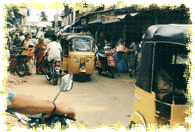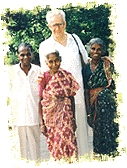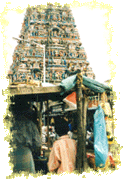 |
 |
 |
|
|||
|
Can Colonial Culture Survive?
Sunithi is over sixty, her granddaughter was about to have an arranged marriage, she is a devout Hindu, but there was no obvious cultural gap - I immediately felt relaxed with her. Her English was precise. - she used words I'd only read in Victorian novels like hillock and thrice and auspicious. I introduced her to Sitaraman, the driver of my hired car who spoke mainly in Tamil. They chatted in their language. Sunithi explained they were discussing the regional government policy of changing street names from English to Tamil. We started off from a main street, Mount Road ,which has a new identity. It's been renamed Anna Salai after a local official. Sunithi prefers the old name.
This one was the residence of a Mr Hall , nobody knows what he did, and it's on Halls road. Now it's home to state administration offices. The building wasn't open to the public but Sunithi talked her way inside -- not difficult in this courteous and hospitable city. The offices were dimly lit with desks and manual typewriters and noisy fans and dusty floors. But the timbered teak ceilings caught my interest (Sinithi said they were termite proof). We went out to the garden which was a mix of British flower beds and exotic jackfruit and custard apple trees. We looked at the facade of the house which though familiar in style was painted bright sea green and red. Punkah, according to the Oxford English dictionary is Hindi in origin and the word dates back to 1807. There was a photo of Punkahs in a church I visited. The caretaker of St Andrews Kirk, the old Scottish name for church,explained they had been replaced by electric fans. The ceiling of the kirk is star spangled. The stars are in the constellations you'd see in the night sky in Scotland. So worshippers as they knelt down to pray wouldn't feel homesick. The hymn obligingly sung by Sunithi along with a stonemason who got down a ladder to join in, and the church caretaker , is in Tamil butit's obviously in the tradition of Western ecclesiastical music. That's Anglo-Indian culture for you. As is common in British churches, there were tombstones along the sides of the church.
Conrad Jamieson from New Zealand and his English wife live and work in a compound owned by a spiritual society which was established in the nineteenth century. It introduced Eastern religion to Victorian Britain. The property is on the outskirts of Chennai, and has a good deal of jungly vegetation. Conrad and his wife, both 80 are tanned and 6 foot tall.
At 5 am next day, the driver took me to find the fishermen. Not all of colonial life was dangerous -- there was obvious luxury. I went to have a traditional breakfast of eggs and smoked kippers at the Connemara hotel named after a popular governor general at the turn of the century. The building has been altered but the entrance is still very grand -- it used to have a portico held up by twelve pillars so guests could arrive on elephants. There are sepia photos on display of British officials partying here with the Indian aristocracy. In those days from the founding of the hotel in 1889, to Indian independence in 1947, each guest was allotted a personal servant known as a bearer, who started work early in the day by bringing guests their morning tea.
If you want to find colonial Madras, go soon, the name change to Chennai announces a new phase in the city's history and self definition. The city is modernizing and many of the old buildings are being pulled down for multi story apartments and offices. But if you look carefully the residue of colonial culture and the fascinating way that it has been grafted onto the fabric of South Indian life, will be there for you. In Chennai, this is Judith Kampfner for the Savvy Traveler.
|
 | American Public Media Home | Search | How to Listen ©2004 American Public Media | Terms of Use | Privacy Policy |






